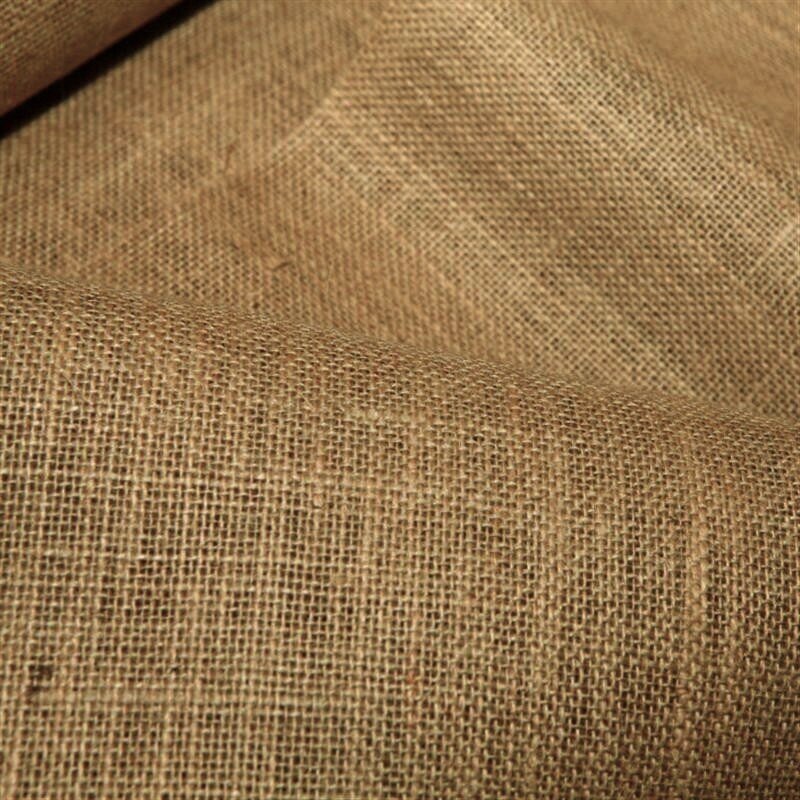Backing material, or foundation fabric, is the most important ingredient in successful punching after your punch needle tool! Punch Needle backing is typically an open weave fabric made of cotton, linen, or a cotton/poly blend, and has between 12-14 holes per inch. Backing fabric that meets these standards are the most versatile, as they will work for both regular and fine sizes of the Oxford Punch Needle (and other punch needles of similar sizing).
Your backing material is so important because it is what holds the yarn loops tightly in place. Contrary to what it may look like, when you punch into backing fabric, you are not creating a hole in the fabric. You are pushing a yarn loop into the holes between the threads of a woven fabric. If the weave of your fabric is too loose, it will be difficult to create enough tension for your loops to stay in place. If the weave of your backing fabric is too tight, the punch needle will simply rip a hole in the fabric. Like Goldilocks, you are looking for that happy medium that is “just right”!
The most common foundation fabric are: cotton monkscloth, rug warp, and bleached or primitive linen for Punch Needle Rug Hooking, and weavers cloth for Punch Needle Embroidery. Some people use jute or burlap, but this is not as highly recommended. Which material you choose should be selected with two main things in mind — what needle you are working with, and what type of finished product you are looking to create.
Below, we'll review a selection of backing fabrics, and the pros and cons of each.


Monkscloth (14 holes per inch)
Pros: very easy to use and learn on, very strong fabric with the softest hand, grid lines can be helpful for beginners, washes well, can use with all Oxford Punch Needle sizes and similar needles
Cons: need to cover the whole fabric or you will see the grid lines
For use with: All Oxford Punch Needles, other similarly sized punch tools
Monkscloth is the most common type of backing fabric for punch needle rug hooking. It is easy to learn on, extremely durable for functional items like rugs, yet has a soft enough hand for it to be easy to work with for a wide variety of projects. It has a bit of stretch, which helps the needle slide in seamlessly. The one thing to note is that not all fabric called “monkscloth” is the same! Some monkscloth has a looser weave with as few as 8 holes per inch, which impacts the durability of the finished project, and makes it impossible to use the finer Oxford needles and other punch needles of smaller size. With the right kind of monkscloth you’ll be able to make just about anything!
(You can purchase Monkscloth by the yard here in our shop!)


Bleached or Primitive Linen (12 holes per inch)
Pros: rustic look, no grid lines, can use with all Oxford Punch Needle Sizes and similar needles
Cons: stiffer fabric, can be a little slippery when punching
For use with: All Oxford Punch Needles, other similarly sized punch tools
Linen has a beautiful, more rustic look which many people enjoy, which is especially nice when you want to leave some of the fabric showing in the background. It can be a little slippery to work with and the weave is a bit stiffer than monkscloth, and not as flexible as rug warp, so check your work constantly to make sure your loops are even on the back as you punch. We recommend linen for rugs and art projects alike.


Rug Warp (13 holes per inch)
Pros: strong fabric, no grid lines, washes well, can use with all Oxford Punch Needle Sizes and similar needles
Cons: thicker than monkscloth, stiffer/heavier hand
For use with: All Oxford Punch Needles, other similarly sized punch tools
Rug warp is a thicker fabric, has good stretch to it when you’re putting it on your frame, and is a sturdy backing option for functional pieces and decorative artworks alike. Since the threads in rug warp are heavier than monkscloth, it is a little stiffer in the feel of punching will be a little harder. We especially recommend rug warp for art pieces and other projects where you want to see some of the backing fabric, and want to avoid the grid lines that are present on monkscloth!


Jute / Burlap
Pros: rustic look, no grid lines, inexpensive, can use with all Oxford Punch Needle Sizes and similar needles
Cons: threads are prone to breaking, fabric will degrade over time
For use with: All Oxford Punch Needles, other similarly sized punch tools
Jute and burlap can provide a nice rustic look to your piece, can have a similar hand to primitive linen, and is much less expensive. However, the punch needle is prone to breaking the threads of the burlap, which will cause your stitches to fall out. It is also not the best choice for longevity, as it degrades over time. If it gets wet or is in a humid environment it is prone to mildew and mold, and if it is dry over time it becomes brittle and can crack.


Weavers Cloth
Pros: no grid lines, relatively inexpensive
Cons: only works for smaller punch embroidery needles
For use with: Ultrapunch, smaller punch needle embroidery tools
Weavers cloth is the go-to backing fabric for smaller punch needles, like UltraPunch and other needles used for a more delicate embroidered look! This material is a blend of cotton and polyester, and works well whether you are covering your fabric or leaving some of the backing showing. The polyester gives the fabric extra strength and flexibility so that the needle is less likely to puncture a hole in the fabric.
Punch needle can be a tricky craft if you're not using the correct materials, and backing fabric is one of the biggest culprits for new punchers! Punch needle will not work on leather, mesh, stretch jersey, synthetic fabrics or denim. However once you get the hang of punching on one of the correct materials, it becomes easier to experiment with other fabrics because you will be familiar with the properties that make a backing easy to use! We recommend looking for a woven, open weave fabric, ideally with a cotton or linen base.

3 comments
Thank you for sharing. I’m a newcomer to punch. This is very helpful.
Hi. I’m 73 yrs of age & when I was growing up my Dad used to do this craft & he made some brilliant floor rugs over the years. I still have his original tools he used & I’m retired & looking to do crafts at home. I still enjoy my lawn bowls & garden, but now looking further down the track when I won’t be so active & it will be less active hobbies. I have wanted to have a go of this for a long time but just never got round to looking into it until now when I found this. Do hope you can help me. I live in Upper Hunter Valley in Scone NSW & would like to know if you have any classes available near. Even Ncle & Sydney near to Quakers Hill or Northmead as we have interests in those areas. Thank you for taking time to read this lengthy message & I await a reply at your earliest convenience.
This was very helpful. Thank you!